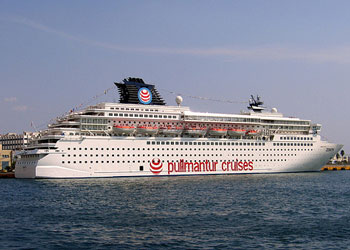
Maybe all of you out there are sick of hearing about the Grandi Navi (Big Ships) kerfuffle, but it’s just about daily news here. It provides a needed (though I wouldn’t say “welcome”) break from the other endless topics, such as everything else that’s screwy around here.
But something happened two days ago which in my opinion changes the entire scheme of the bureaucratic/political/economic volleyball game between the Comune, the small but obnoxious band of protesters, and the Port Authority.
As you know, there has been and continues to be an exhausting back and forth between these factions about What to Do About the Big Ships. All these heated remarks and assertions, which keep fizzing and flaming like sodium dropped in a glass of water, are based on the conviction that a big ship is a clear and present and inevitable and catastrophic danger to Venice. Every remark on the subject, like acqua alta, starts from the unstated assumption that it is inherently hazardous.
As you also know, I am not convinced. Not being convinced doesn’t mean that I find the behemoths attractive, but there is a difference between something being ugly and something being bad. The protesters don’t want them in the city for reasons which have nothing to do either with the ships or the city, and so have created an issue where one didn’t exist before, and doesn’t have to exist now, either.
The subject has been twisted around in a way that brings to mind the observation of Seneca the Younger regarding the difference between the Roman and Etruscan outlook on the cosmos:
“Whereas we believe lightning to be released as a result of the collision of clouds, they believe that the clouds collide so as to release lightning: for … they are led to believe not that things have a meaning insofar as they occur, but rather that they occur because they must have a meaning.”
Because the big ships could be dangerous, we have to assume that they will be dangerous.
Don’t misunderstand. I think it would be a terrible thing if a big ship suddenly lost control and ran into the Piazza San Marco killing countless people and cleaving the Doge’s Palace in twain. I also think it would be a terrible thing if an eagle dropped a turtle on my head. So many terrible things hurt and/or kill people every day — abusive husbands, cigarettes, car crashes, malaria-bearing mosquitoes — that fixating on the big ships seems excessive.
But there’s good news!
Two days ago a sort of fire-drill occurred. It wasn’t planned, and it wasn’t fun, but in my opinion it demonstrated that the people who would have to deal with the much-dreaded emergency in the Bacino of San Marco are very much up to the task.
A Big Ship named “Zenith” (soon, I guess, to be rechristened “Nadir”) carrying 1,828 (or 1,672) passengers and 620 (or 603) crew members caught fire. That is, a fire broke out in the engine room. The ship was not far from Chioggia, in the first night of its cruise heading toward Venice. The fire was quickly brought under control, but the ship lost all power and was anchored ten miles offshore (seasick pills anybody?), in the dark, etc. Scenarios that are too familiar from recent Carnival line carnivals.
At 4:20 AM, after having spent ten hours trying to get the engines started, the captain called the Capitaneria di Porto for help and a flotilla of assistance was immediately thrown into action. Three large motor patrol vessels of the C di P began heading south, along with a large fireboat with firemen, two big tugboats (“Marina C” and “Hippos”), soon followed by another two (“Angelina C” and “Ivonne C”). Aboard the tugboats were more firemen and seamen from the Coast Guard. Also divers.
The tugboats managed to attach their towlines to the ship — not easy in a heavy sea — and tow her into the lagoon at Malamocco at about 4 knots/7 kilometers per hour. All this took most of the day. At 11:00 PM the ship was finally moored at the industrial zone at Marghera. Total elapsed time: 20 hours.
Why is this good news? First of all, the passengers lived through it and the experience didn’t last for days and days, as has been the case in some other similar events.
Second, and most important, the Venetian maritime system showed itself highly capable of resolving this emergency in admirable form.
So if they were able to accomplish all this in a long and complicated situation, why would they not be able to intervene immediately in the Bacino of San Marco if a Big Ship lost power, when two tugboats are already attached, and there are rarely waves or wind to match those of the open sea?
Maybe Seneca the Younger has the answer to that. My answer is that it appears they’d be able to do just fine.
